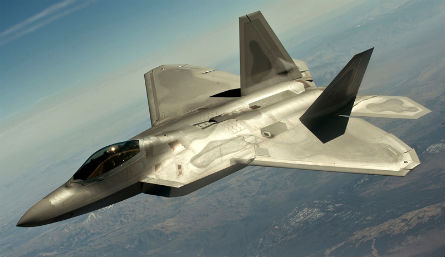The US Air Force has begun to deploy Lockheed Martin F-22 Raptors upgraded with enhanced air-to-ground strike capabilities to the operational fleet, starting with the 3rd Wing at Joint Base Elmendorf-Richardson in Alaska.
"The 525th Fighter Squadron was the first Combat Air Forces squadron to receive an [Increment] 3.1 modified aircraft," says squadron commander Lt Col Paul "Max" Moga. "The capabilities this incremental upgrade brings are a complete game-changer for the F-22, making it even more lethal and survivable in combat."
The unit's flagship, tail number 4115, is the first aircraft to be equipped with the modifications, which add a synthetic aperture radar (SAR) capability, electronic attack, better geo-location capabilities to find enemy radars, and the ability to carry eight 113kg (250lb) GBU-39 small diameter bombs (SDB).
The Increment 3.1 upgrade allows a pilot manually to designate two ground targets at a time using two weapons each, according to Lockheed, enabling an F-22 to hit four separate targets with its eight weapons. By contrast, the USAF's previous Increment 2 configuration enabled each aircraft to strike two fixed targets using its two 454kg Joint Direct Attack Munition satellite-corrected, inertially guided bombs.
 |
|---|
© US Air Force |
"A four-ship of Increment 3.1 aircraft can successfully find, fix, track, target and engage targets in the most challenging of anti-access environments," Moga says. "Stealth and speed, combined with an advanced electronic attack capability, allow pilots to operate with impunity while achieving their mission objectives."
The Northrop Grumman APG-77 radar's SAR mode creates black and white photo-quality images of the Earth's surface, allowing pilots to pick their own targets, while the new electronic attack capability allows the F-22 to jam enemy radars using the sensor.
A future Increment 3.2 upgrade has been split into smaller packages called A, B and C. The first is scheduled for fielding in 2014, while the second would begin retrofits in 2017. The third has not yet been fully defined, but the USAF is trying to add open-architecture hardware and software.
Further elements of the future upgrade package include adding Raytheon's high off-boresight AIM-9X and AIM-120D Amraam missiles, and the ability to independently retarget up to eight SDBs against eight separate targets. The Raptor will also gain an automatic ground collision avoidance system and electronic protection to defend it from enemy jamming.
Source: Flight International



















